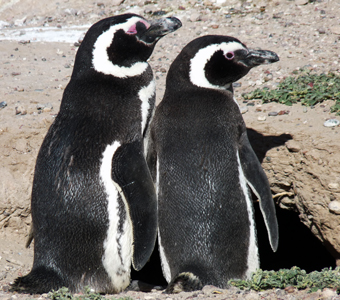
Natural selection on morphology varies among years and by sex in Magellanic Penguins (Spheniscus magellanicus)
Laura E. Koehn , Jeffrey J. Hard , Elaine P. Akst , and P. Dee Boersma
The Auk 133(4):783-805. 2016.
Abstract
The evolution of morphology in a population reflects several factors, including the influence of environmental variability on natural selection. We estimated natural selection on, and heritability of, 4 individual morphological traits (bill length, bill depth, flipper length, and foot length) and 2 multivariate morphological traits in adult Magellanic Penguins (Spheniscus magellanicus) at Punta Tombo, Argentina, from 1983 to 2010. We estimated heritability of morphology with parent–offspring regression and animal models, conditioning on sex because the species is sexually dimorphic. For the analysis of selection on each trait, we estimated both linear and quadratic selection gradients, based on the number of fledglings produced, for breeding males and females in each year. Estimates from animal models indicated that all 6 traits were heritable; in parent–offspring regressions, corresponding heritabilities were significantly higher in sons than in daughters in 100% of tests. Over 28 yr, we detected no selection in 21 yr for males and in 21 yr for females. For the years in which we did detect selection, the direction and intensity of selection on traits varied, being especially variable for females. We detected selection on primarily multivariate body size but also on male bill sizes and female bill and foot lengths. Selection on male flipper and foot lengths and on female bill depth was detectable only in relation to selection on body size. When there was selection in males, selection on body and bill sizes was mainly toward larger sizes and occurred in 4 of 6 yr with high chick starvation. The absence of detectable selection on morphology in most years suggests that it is not tightly linked to fitness and that the dynamic environment where Magellanic Penguins live helps maintain morphological variation. The temporal variability in selection likely fosters stability of morphology through time, a pattern that might not be evident in short-term studies.